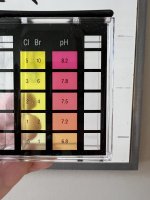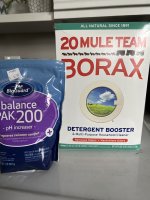- Mar 5, 2020
- 3,221
- Pool Size
- 66000
- Surface
- Plaster
- Chlorine
- Salt Water Generator
- SWG Type
- Astral Viron V35
I assume with test kit you are referring to a drop test?
Your alkalinity should still be high enough to have pH not drop too low.
Alkalinity means the water can buffer the effect of added acids on pH. In your past, you needed a good level of alkalinity to compensate the acidity from the chlorine tabs. Now it helps with the acidity created by chlorine neutralising ammonia. In your future, when chlorinating solely with liquid chlorine or an SWG, there are no more acid sources in your chlorination routine, and you won't need as much alkalinity.
There is another effect of alkalinity, which helps you in this case, and helped you in your chlorine tab past, to not just buffer the effect of acids, but actually actively raise pH:
Alkalinity consists mainly of carbonates, resulting in an oversaturation of dissolved carbon dioxide which gasses gradually out (think opening a soda bottle), raising pH in the process. In your current situation, this is good for you. In your future this will actually be annoying, and without the regular acid addition via chlorine tabs, we recommend to maintain lower alkalinity levels (around 60-70 is usually pretty good, just not below 50).
For now, you want some alkalinity, 80 is not bad. I'd bring it maybe up to 100 for now and then you should be OK. That would be about 100 oz of baking soda in your 20k gal pool (by the way: Alkalinity Increaser from the pool store is just that: plain old baking soda, identical to the one you can buy in grocery stores).
Keep an eye on TA and pH during the ammonia killing process.
Do you have a heater bypass so you can decouple your heater during the ammonia neutralisation?
Your alkalinity should still be high enough to have pH not drop too low.
Alkalinity means the water can buffer the effect of added acids on pH. In your past, you needed a good level of alkalinity to compensate the acidity from the chlorine tabs. Now it helps with the acidity created by chlorine neutralising ammonia. In your future, when chlorinating solely with liquid chlorine or an SWG, there are no more acid sources in your chlorination routine, and you won't need as much alkalinity.
There is another effect of alkalinity, which helps you in this case, and helped you in your chlorine tab past, to not just buffer the effect of acids, but actually actively raise pH:
Alkalinity consists mainly of carbonates, resulting in an oversaturation of dissolved carbon dioxide which gasses gradually out (think opening a soda bottle), raising pH in the process. In your current situation, this is good for you. In your future this will actually be annoying, and without the regular acid addition via chlorine tabs, we recommend to maintain lower alkalinity levels (around 60-70 is usually pretty good, just not below 50).
For now, you want some alkalinity, 80 is not bad. I'd bring it maybe up to 100 for now and then you should be OK. That would be about 100 oz of baking soda in your 20k gal pool (by the way: Alkalinity Increaser from the pool store is just that: plain old baking soda, identical to the one you can buy in grocery stores).
Keep an eye on TA and pH during the ammonia killing process.
Do you have a heater bypass so you can decouple your heater during the ammonia neutralisation?



